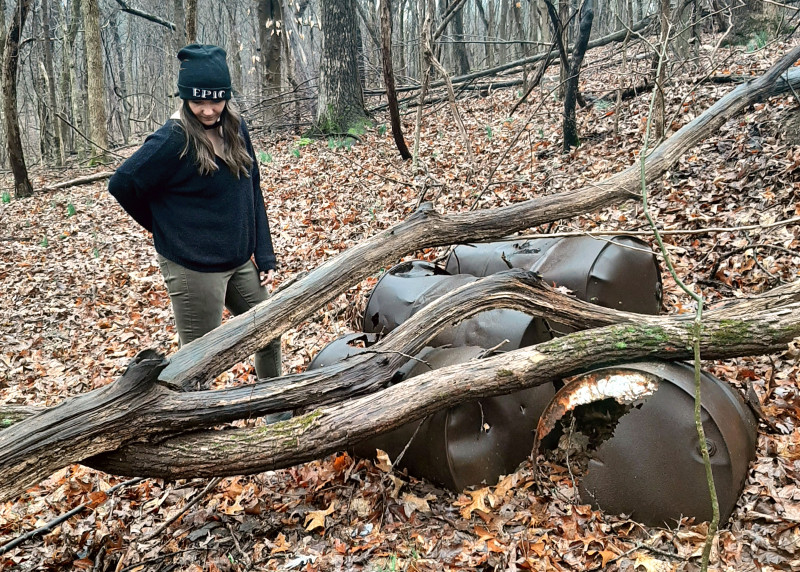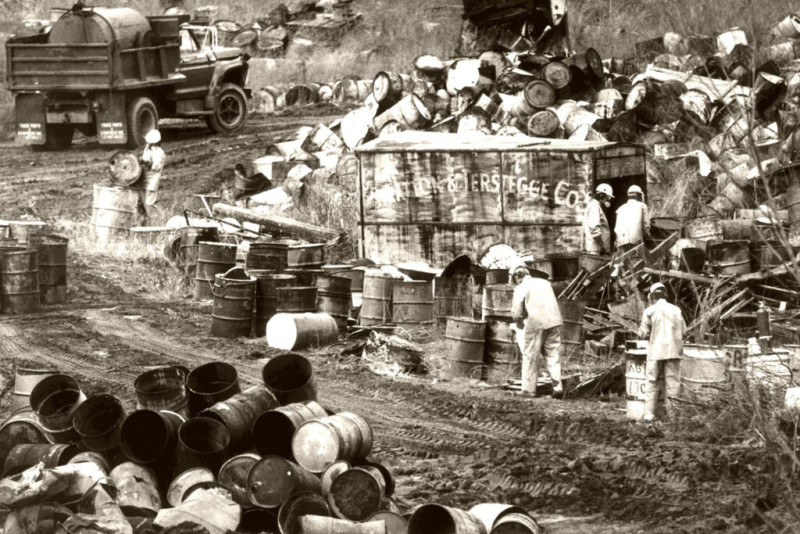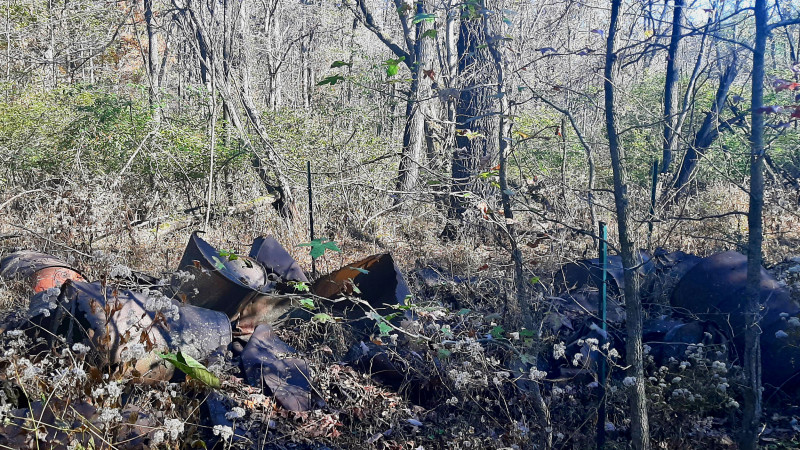Louisville Finally Takes Stock of Abandoned Waste Dump Inside a Preserved Forest
LOUISVILLE, Ky.—Environmental consultants this summer will be digging trenches and taking soil samples in this city’s Jefferson Memorial Forest, looking to document new evidence of toxic waste dumped there decades ago.
Louisville Metro Council on June 20 approved a $68,000 contract with Shield Environmental Associates for the work. The company, with offices in Louisville and Lexington, last studied the site over a decade ago. Kentucky environmental regulators commissioned that 2011 assessment, which estimated cleanup costs of as much as $900,000 to remove partially buried drums and contaminated soil.
But the cleanup never occurred. That was just one of the balls dropped by federal, state and local government agencies going back more than four decades.
The full extent of the bureaucratic bungling was exposed earlier this year by a recent University of Louisville graduate student, Sam Satterly, and reported first by Inside Climate News. Her master’s research revealed previously untold connections between the largely unknown “Gully of the Drums” and the much larger and nationally infamous “Valley of the Drums,” which was located just several hundred feet away before it was cleaned up in the 1980s.
Explore the latest news about what’s at stake for the climate during this election season.
The Jefferson Memorial Forest is a 6,600-acre sylvan landscape known for its steep hills and hardwood canopy of beech, maple and oak trees, its understory dotted with flowering dogwood and redbud trees. The forest has served as a memorial to veterans since 1948.
“This forest holds a special place in my heart,” Satterly said in an interview earlier this year at a coffee shop, where she sifted through documents she had obtained through public records requests and court files. “It has offered me sanctuary in times of anguish and peace in times of sorrow.”
Satterly, an Iraq War veteran, said, “Sadly, we have treated it, in many ways, like a forgotten military veteran.”

Kentucky in 2016 Described an “Imminent Threat”
The Gully of the Drums sits about 700 feet from the “Valley of the Drums,” where some 17,000 hazardous waste barrels were discovered in the late 1970s about 17 miles south of downtown Louisville. Images of the massive stockpile scattered on 23 acres, along with the frightening revelation of chemical plant dumping in New York’s Love Canal, led Congress in 1980 to pass the Comprehensive Environmental Response, Compensation, and Liability Act, commonly known as Superfund.
The law authorized a tax on chemical and petroleum industries to pay for the cleanup program. It also gave the U.S. Environmental Protection Agency the authority to directly respond to toxic dumps that threatened the public or environment, then assess cleanup costs on the “responsible parties.” The Valley of the Drums was among the first sites to be cleaned up with the new federal mandate.
But EPA didn’t clean up the much smaller Gully of the Drums at the same time. And at least twice since then—after EPA had declared the Valley of the Drums cleanup a success—Kentucky environmental regulators and EPA officials found pollutants lingering in the soil at the gully site at levels that would normally spur remediation.

Across the country, there are likely many smaller dump sites such as the one in Jefferson Memorial Forest that “fell off the charts and went into oblivion” as EPA and states were inundated with reports of toxic dumps to investigate in the 1980s, said Louisville environmental attorney Tom FitzGerald, who has looked into legal issues related to the site.
The gully site is far smaller than the Valley of the Drums. Official estimates have pegged the number of visible waste barrels at 40 to 45.
The (Louisville) Courier-Journal published a story in 2008 about the “discovery” of an estimated 40 rusting drums inside Jefferson Memorial Forest, noting a push by state and federal regulators to get the extent of any pollution there evaluated and remediated.
When Shield completed its study in 2011, it noted drums and other containers strewn along swaths of the forest for about 300 feet, along with buried metal and potential waste nearby. The firm found evidence of elevated levels of heavy metals and pesticides.
Satterly’s research uncovered a 2016 letter from state officials to the Michigan chemical company Dow Corning, telling the company they had found containers with its logo. The letter declared that the site was an “imminent threat to human health and the environment,” and told Dow Corning it needed to clean up the dump site.
Dow Corning, which was split up in 2016 and partially absorbed by Dow, the Michigan chemical company, replied at the time that it had worked with state officials in 2012 and 2013 to address their concerns and had “submitted a proposal, with the agency’s knowledge, to the [city parks department] for participation in a possible response action. Your letter is the first communication we have received since then; it suggests that you are unaware of or indifferent to those discussions,” the company said.
Dow Corning further said at the time that it did not believe it had any legal liability for the forest dump site and would not commit to participating in its remediation.
State officials declined to answer questions about what happened to the cleanup talks they had with Dow Corning.
Satterly also found records showing the same person who created the Valley of the Drums in the 1960s, the late A.L. Taylor, who owned that land, was also dumping waste at about the same time on the neighboring property that would become the Gully of the Drums.
By the end of the 1960s, Jefferson County had agreed to clean up the gully following a legal dispute over the property’s ownership and claims that county officials had allowed the dumping. But there’s no evidence any such cleanup ever happened.
City Commits to “Getting This Right”
State officials nudged the city into conducting the new study Shield will now do. A state Energy and Environment Cabinet spokesman, John Mura, said Wednesday that the study should define the extent of waste material and characterize related soil contamination so officials can develop a corrective action plan. “The Cabinet expects [Louisville] to implement the cleanup and report the results to the Cabinet,” he said in an email.
The city, through Mayor Craig Greenburg’s spokesman Kevin Trager, has declined interview requests about the Gully of the Drums. But in a written statement Wednesday, Trager downplayed the site’s risk, saying it’s located in a remote area away from park amenities and parking areas.

“While further site investigation is needed—which is the contract just approved by the Metro Council—we have no reason to believe the active spaces and trails in the forest present the public with anything other than the opportunity for high-quality natural experiences,” he wrote.
Trager said the city would determine “next steps” after Shield completes the study. “We are committed to getting this right for those who visit … and the neighbors who live nearby.”
The Shield contract runs through Sept. 1.
One Metro Council member, Dan Seum Jr., a Republican whose district includes the memorial forest, is adamant that the city will clean it up, and quickly. He noted that state lawmakers this year allocated $2.5 million toward land acquisition and improvements at the forest and said he plans to ask the state for more.
The goal, he said, is to make the forest a regional destination. Cleaning up the Gully of the Drums will be critical to that effort, he added.
“Whatever has to be done, it will be done,” Seum said. “And we will be transparent.”
One of Satterley’s professors, Lauren Heberle, chair of sociology and an expert on Superfund cleanups, said she’s “very encouraged” that Louisville is poised to complete the original Shield environmental assessment from almost 15 years ago.
Heberle credited Satterley’s research and public discussion about it for spurring action. “I’m glad to see Louisville Metro government take responsibility for completing the assessment and hope they will also follow up on remediation in a way that cleans the site of any remaining toxic or hazardous materials,” she said.
Satterley is hopeful cleanup will finally happen.
“I cannot put into words how that makes me feel,” she said, “but it certainly makes my heart swell.”
Share this article
Disclaimer: The copyright of this article belongs to the original author. Reposting this article is solely for the purpose of information dissemination and does not constitute any investment advice. If there is any infringement, please contact us immediately. We will make corrections or deletions as necessary. Thank you.








